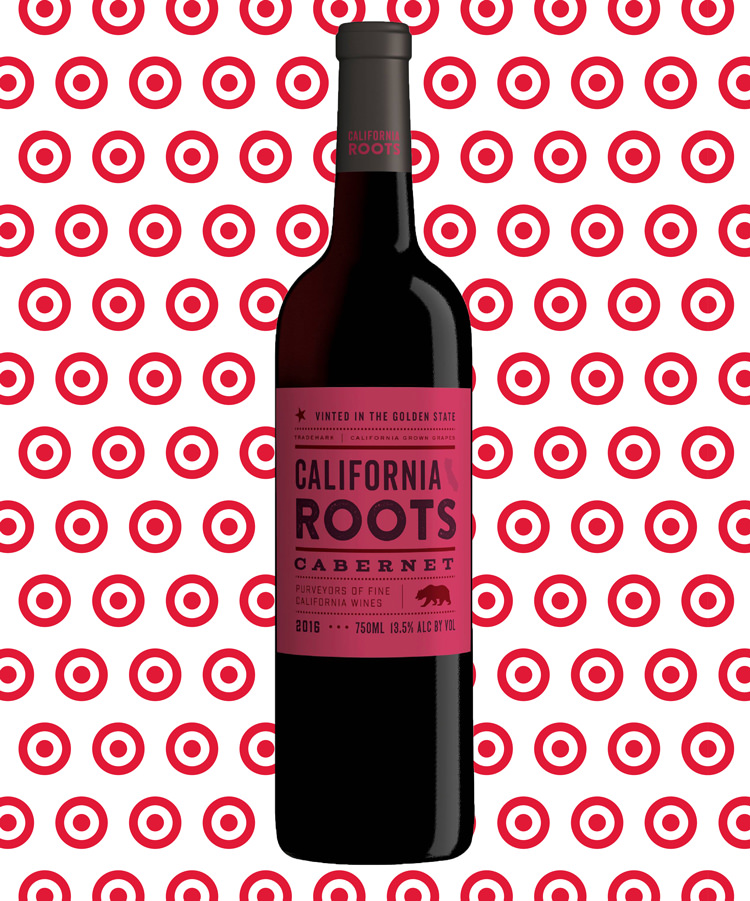
Trader Joe’s has Charles Shaw, a.k.a Two Buck Chuck. Whole Foods has Three Wishes. And as of September, Target has California Roots, its answer to the uber-popular “super value” wine category.
While we at VinePair are a bit wary of California Roots’ dubious origins, we are also far too curious not to taste the viral, $5 Target wines. After a quick trip to New Hampshire, one of the states in which Target can legally sell wine, we enlisted two New York sommeliers to blind taste all of the California Roots wines to give you the scoop on how they truly measure up. No labels, no snobbery, no preconceived notions.
Target’s California Roots line consists of five wines: Pinot Grigio, Chardonnay, Moscato, Red Blend, and Cabernet Sauvignon. The wines do not list a place of origin more specific than California, but based on the math of super-cheap wines, grapes likely come from a hot, fertile region like the state’s Central Valley. Pro tip: While all California Roots wines are $5 each, Target offers a 10% discount on six bottles or more.
Joining me for the blind tasting panel were Katie Venezia, sommelier at Marta in New York, and Gabrielle Neuberg, sommelier at Union Square Cafe in New York. Our participants were unaware of the wines’ brands, regions, grape varieties, vintages, or prices until tasting and discussing all five wines. Panelists were asked to describe the wine, detail the person they would theoretically sell it to, and guess the average retail price. (Spoiler alert: Maybe New York somms can’t fathom that a wine could cost $5 because they thought every wine was more expensive than it actually was.)
Ready for the down-low on the latest cheap wine to hit the market? Hold onto your spit buckets — it’s Target wine time.
California Roots Pinot Grigio 2016
Tasting Notes
It seems like it is intended to be a dry wine, but there’s definitely a little residual sugar on the palate. Oddly, it’s a little spritzy, but it comes off as heavy, flabby, and lacking in acidity. The green apple Jolly Rancher-reminiscent nose burns, like chemicals, and it tastes artificial, like Sprite.
Panel Comments
“I get some minerality, maybe.”
“You think there’s minerality here?!”
“Maybe it needs ice cubes.”
The Verdict
The Pinot Grigio is the cheap wine option for someone who wants a porch-pounder or covertly smuggled beach wine. Just be sure to drink it super cold to make it as tasteless as possible. Our panel’s price estimate: $9 to $11.
California Roots Chardonnay 2016
Tasting Notes
Overripe, almost rotting pineapple and candied green apple fruit dominate the Chardonnay, with notes that give the illusion of oak but clearly come from oak chips or powder. The wine is fat but not buttery or creamy, like high-quality oaked Chardonnay. The alcohol seems too high and unintegrated, lingering on an unpleasant finish.
Panel Comments
“My mom would crush this wine.”
“It tastes like cheap Chardonnay.”
“This is for someone who doesn’t care what they’re drinking.”
The Verdict
This was our least favorite of the Target wines, largely because it tasted like a manufactured version of stereotypical California Chardonnay. The panel agreed that it was a wine for people who don’t want to spend a lot of money but seek a richer style of wine. (Side note: Buzzfeed alleged that a person could easily pass this off as a $20 bottle of wine. According to our panel, that’s a definitive “no.”) Our panel’s price estimate: $8 to $12.
California Roots Moscato 2016
Tasting Notes
Intensely perfumed on the nose, with notes of peach, lemon-lime soda, and candy-scented perfume, the Moscato smells artificial but bright. It’s definitively sweet but more put-together than expected, with a palate that finishes on a tart note. Think of Flintstone vitamins or Sweet Tarts.
Panel Comments
“It’s sweet! I didn’t expect that.”
“It tastes Moscato-y.”
“This is cheap.”
The Verdict
Shockingly, despite its sweetness, the Moscato was the favorite white wine option in the Target lineup because it had slightly more acidity than the Pinot Grigio and Chardonnay. Be forewarned: It tastes like Skittles. Our panel’s price estimate: $6 to $8.
California Roots Red Blend 2016
Tasting Notes
Ripe, round mixed berry fruit makes the red blend seem Zinfandel– or Shiraz-like at first, with pleasantly surprising notes of coffee and warm earth. The palate seemed to be in balance, though one panelist postulated that it might be acidified, with smooth, juicy blueberry fruit and baking spice.
Panel Comments
“It’s not as bad as I thought it was going to be.”
“I’d be fine with it at a house party.”
“I’m actually impressed by this.”
The Verdict
It seems that the increasingly popular yet insufficiently named red blend category has some merit when it comes to super-value wines; this was the panel’s favorite by far. It was more balanced and complex than the others, so if it were the only option at a wedding or banquet, we’d be fine with drinking it. Our panel’s price estimate: $15.
California Roots Cabernet Sauvignon 2016
Tasting Notes
It was immediately evident that this is Cabernet Sauvignon — the dusty, green bell pepper notes of pyrazines are a dead giveaway. But the fruit is hot and jammy with a metallic undertone, likely an indicator of the scorched grapes’ hot origin. On the palate, the wine is fat and high in alcohol, without enough tannic structure to support it. There are some non-fruited, bitter, meaty notes, but they aren’t necessarily positive.
Panel Comments
“This is what you get at a bar as their nondescript house red wine.”
“Why is it so metallic??”
“There aren’t enough tannins to support the booze.”
The Verdict
While the Cabernet Sauvignon was more than just a one-note wine, the panel wished that it had been more singular, as its non-fruit flavors were fairly harsh and unpleasant. If we had to drink it, we could, but we’d rather be drinking the red blend. Our panel’s price estimate: $10.
